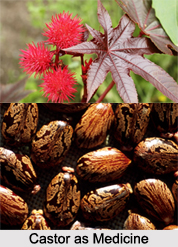 Castor plant is botanically known as Ricinis Communis. Two varieties of the plant are described, namely red and white. Their properties are said to be identical. The ripe seeds of the plant are pressed to make Castor Oil.
Castor plant is botanically known as Ricinis Communis. Two varieties of the plant are described, namely red and white. Their properties are said to be identical. The ripe seeds of the plant are pressed to make Castor Oil.
Health Benefits of Castor
The root of Ricinis Communis and the oil obtained from the seeds have been used in medicine by the Hindus from a very remote period. They are mentioned by Sushruta. Castor oil is regarded as purgative and useful in costiveness, tympanitis, fever, inflammation, etc. It is much praised for its efficacy in chronic rheumatic affections in which it is used in various combinations. One of its synonyms is "Vatari" or anti-rheumatic. The root of the plant is also said to be particularly useful in the local varieties of rheumatism such as lumbago, pleurodynia and sciatica.
Dose of Castor in Medicine
The root of Ricinis Communis enters into the composition of various compound prescriptions for rheumatic affections and diseases of the nervous system. In affections of the eyes, castor oil leaves and roots are used in a variety of forms and several prescriptions containing them are given by most writers. A decoction of the bark, leaves and root of the plant in goat"s milk and water is recommended for use as a wash in recent ophthalmia.
As a purgative, castor oil is recommended to be taken with cow"s urine, or an infusion of ginger or a decoction of the combination called Dasamula. The seeds, freed from impurities and rubbed into a paste, are boiled in milk and water, and the decoction is given in lumbago and sciatica. In pleurodynia, or pain in the sides, a decoction of the root is given with the addition of Yavakshara.
This article is a stub. You can enrich by adding more information to it. Send your Write Up to content@indianetzone.com
Related Articles
Ayurveda
Sushruta Samhita
Classification of Medicine
Properties of Material Objects and its Effect on Human Body
Indian Herbs
Traditional Indian Medicines





